To get to the Caribbean Coast we had to take our first overnight bus in Colombia. Throughout South America we had been warned of arctic overnight buses caused by powerful
air conditioning, but having never experienced anything other than the natural cold on the journey to La Paz we dressed light in hopeful preparation for the warmness of the Caribbean. Needless to say now was not the time to
be getting smart and we froze for the whole journey and got no sleep. Even changing seats to get away from the air vents and Jo wearing a spare pair of trousers on her arms didn’t help. Thankfully the heat in the north was everything
that we expected it to be and we soon warmed up, then some and then some more.
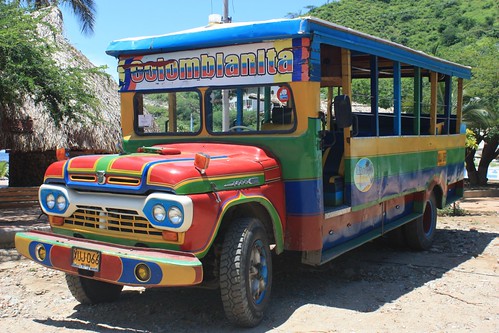
Our first stop on the coast was at Santa Marta, which is the place of Simon Bolivar’s death and is known as the Pearl of the Americas. I’m still dumbfounded as to how
it got this name, the towns main beach made me long for beaches of ........England! The beach and the water were dirty, probably due to the sewerage pipe pumping god knows what into the ocean. There really isn’t much to
see and do in Santa Marta except get reacquainted with our arch enemigo, the mosquito. However, it is a good base to explore some nearby attractions.
Taganga
is just a small fishing village located about 10km from Santa Marta. Well it used to be a fishing village but now it seems to be overrun with backpackers and every business
seems to be set up to cater to the influx with prices to match, sadly seeming to have lost it's traditional ways, apart from the sale of shark oil perhaps.

To escape the oppressive heat I decided to get underwater for a couple of days and do an advanced diving certification. Many, both reputable and disreputable,
dive shops have opened in Taganga, so after some research I decided to go with Aquantis. Things got off to a great start when my dive instructor Desi turned out to be a local who looked like Easy-E but thankfully without
the squeaky voice.
As part of the certification we had to do a night dive, which didn’t start out too well as there was no visibility and it was like everything you would fear being underwater
in pitch darkness would be. But after passing through the murky first five metres, the vis improved and we got to see a whole different world. Fish that we had seen during daylight were sleeping and it was quite funny to see
some of them bumping into the coral and rocks as they slept. As coral changes at night different fish come out to feed and work, so we got to see many different species of fish as well as lobsters and crabs. After learning
to trust the equipment it turned out to be one of the best diving experiences I’ve had, especially the buzz of not knowing what could be lurking just out of the range of the light!
Tayrona
We returned briefly to Santa Marta to catch transport to Tayrona National Park, which as well as having the usual flora and fauna found in tropical settings is also home to
some stunning beaches. We had been warned by fellow travelers that due to the rainy season the trek within the park was pretty muddy, but with little other choice I decided to tackle the trek in thongs/flip flops. It’s
safe to say that it was totally inappropriate footwear and I spent most of the time slipping and squelching around and then having to stick my hand into a combination of mud and horses doofus to retrieve a lost flip flop.
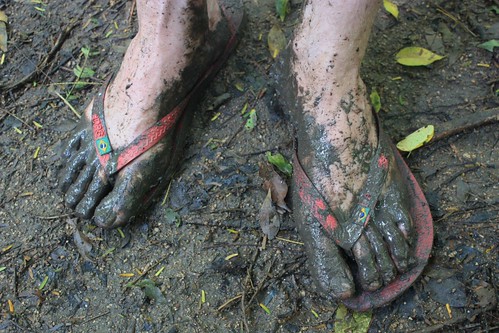
This made it a tough and very sweaty walk, and then much to our horror after arriving at the first beach we were met with no swimming warning signs due to strong currents
and rips. We had been looking forward to being able to cool down in the sea but we could only look but not dip, this must be what torture feels like!
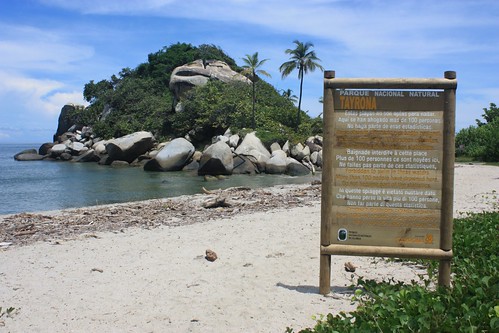
We continued our trek which got worse due to horses churning up the path and despite taking more than twice the amount of time suggested it was all worth it when we arrived
at our final destination and the beach of Cabo San Juan de Guia.


As it had taken so long to get there we decided to stay the night and not wanting to pay the exorbitant room prices we decided to have our first venture of sleeping in hammocks.
It was a little strange at first but I could certainly get used to falling asleep to the sounds of frogs croaking and waves breaking on the shore.
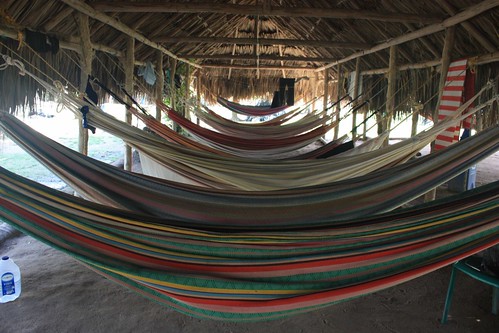
After a couple of days relaxing and swimming in the stunning surroundings, we decided to head back to one of the beaches we had passed on the way in and again spend the night
sleeping in hammocks. Our time and the beaches in the National Park certainly made up for the rather disappointing beaches in Santa Marta and Taganga and were everything we were looking forward to in the Mar Caribe.
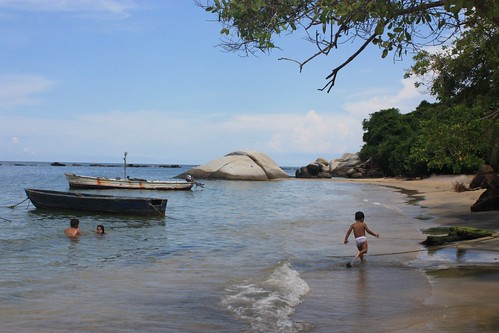
The next day we had an early morning dip before slip sliding our way back through the muddy trail, where we were lucky enough to see a pack of wild monkeys playing in the
trees, even daring to come quite close to us, probably to check out the awful sound Jo was making in an attempt to imitate their calls.
Cartagena de Indias
We’ve seen a fair few Spanish colonial cities during our time in South America, and while we were surprised by the architecture in Bogota, I think we saved the best until
last, as nothing compares to the beauty of Cartagena’s walled city. The city’s best attraction is simply walking around the old part, along its fortified walls and reliving a time from yesteryear.
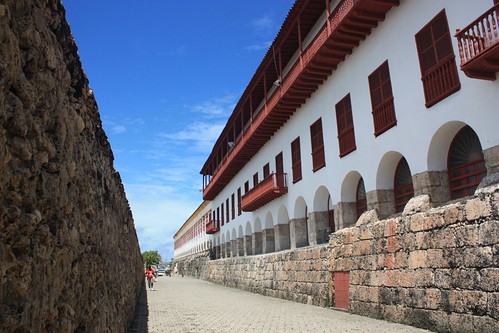
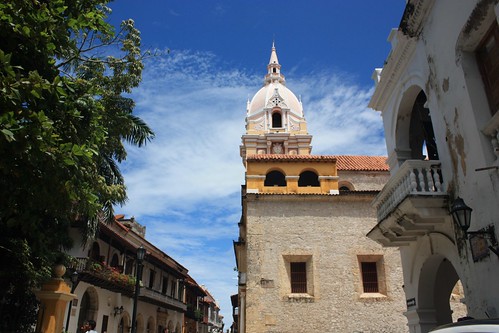
Outside of the old city is Castillo San Felipe de Barajas where we were able to get up close to the huge Colombian flag which adorns the fort, as well as exploring it’s
labyrinth of tunnels which are not suitable for the claustrophobic amongst us and gave us an idea of how the fort was defended and why nobody was ever able to capture it during battle.
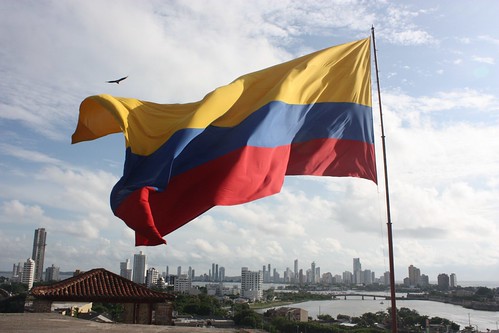
Cartagena’s history is filled with tales of pirates of the Caribbean, attacks against Spanish rule and
attempts to control one of the most prosperous ports in the Americas. So no trip would be complete without visiting its slightly creepy Inquisition Museum with all its torture apparatus, which was made all the more spooky
because the museum was housed in the building where the torture took place. After all that gore we needed a coffee from one of the many coffee vendors that can be found on the streets of Colombia, armed with their thermos
flasks full of tinto. Is there anywhere else in the world you can get an expresso for 10p?
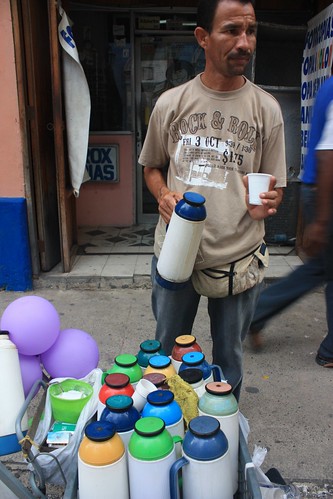
Darien Gap
Although South and Central America are connected by land, there is no road between them due to the almost impassable 100 by 30 miles of swampland and forest known as the Darien Gap.
Most people wanting to get to Central America either fly or get a sailboat from Cartagena to Panama. We prefer not to fly due to the environmental footprint and because you miss the scenery, which in Colombia has been particularly
spectacular. We have also recently heard horror stories from other travelers of drunk captains, insufficient food and water, getting lost at sea for days and terrible sea sickness on the sailboat cruises. As the Darien Gap
area is controlled by FARC guerrillas and drug cartels, it is considered lunacy to try and cross to Central America here...
However, we decided we wanted to see some of this famous hinterland and one of the last frontiers of the Americas for ourselves (and it’s a much cheaper way to get to Panama).
To get to the Darien Province required two long bus journeys, which included being told by the bus conductor after 13 hours of travel that he had forgotten to tell us to get off the bus. Maybe this was karma
for getting an advantageous free ride in Ecuador the last time a conductor forgot to tell us we had reached our destination! Dusty, hungry, aching and tired we were dropped off on the side of the road in pitch darkness and
had to try and catch a bus back to our destination an hour away. Catching a bus was no problem as all buses seemed to be heading to our final stop of Turbo. However, the sole purpose of our new bus seemed to be shuttling drunken revelers between drinking establishments on the journey. Lets just say that we stuck out like sore thumbs and received our fair share of strange looks and leave it at that :)
With nothing of interest to see in Turbo, the next day we got up early to buy tickets for the launch boat to Capurganá. We were told the journey can be rough and the
earlier you get your tickets the more chance you have of getting the better seats at the back of the boat where the ride is less bumpy. Thankfully we managed to get some good seats, although it turned out the journey was quite
calm anyway. The only problem was the blistering heat that we could feel burning us every time the boat stopped at destinations along the way and we weren’t allowed to jump into the clear waters of the Gulf of Urabá to help cool
off.
Capurganá
Just as you were thinking we’d lost our minds, we’re not really adventurous or crazy enough to attempt to travel through the thick of the Darien Gap, we merely decided
to skirt around the edges of it. The situation in Capurganá has improved greatly in the last few years and the area is now under government control and is considered safe to travel to. With no roads or cars and with it’s beach and all sides of the
town surrounded by the jungle, it felt like we were on an island despite still being on the mainland.
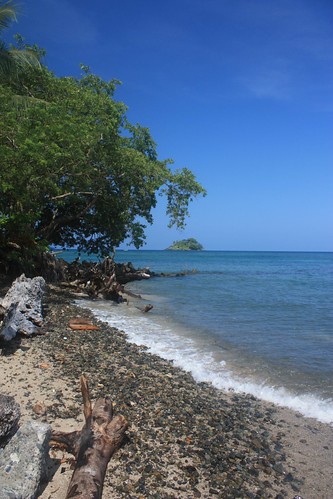
Due to the regions previous problems there is a strong military and police presence in Capurganá and we certainly felt sorry for the soldiers who patrolled the beach in full
army gear, including boots and guns, in the sweltering heat while we lazed on the beach, cooling off in the cerulean waters and enjoying coco loco’s, which are a mixture of fresh coconut milk, rum, rum and more rum.

In the next bay along from Capurganá is the small town of Sapzurro, which is Colombia’s final frontier town before Panama. You can get there by boat but as one of the reasons
we had come was to see the Darien we decided to take the 3km trek through the jungle. Now 3km doesn’t sound very far but this trek was through really thick jungle and it took us nearly 2 hours to complete. Along the way,
as well as seeing many lizards, giant mosquitoes and bugs of all kinds, we encountered a snake on the path, some sprightly spider monkeys and lots of green and black poison dart frogs.

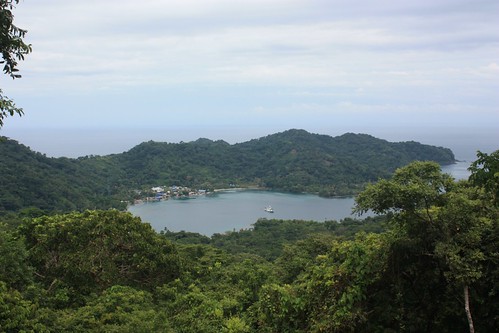
From Sapzurro you can cross into Panama to the tiny hamlet of La Miel, but you can’t stay there because it’s not an official border crossing so you have to register and
return the same day. To get there you have to walk up a series of steep stairs to the border checkpoint.
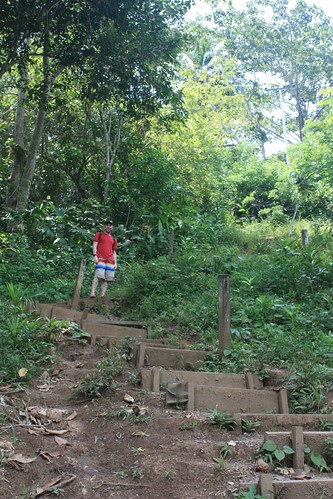
This, in our book, is how we lay claim to crossing from South to Central America on foot via the Darien Gap!!!
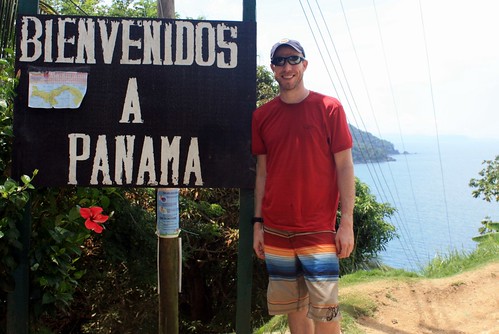
At the check point we noticed that while the Panama flag was proudly flying there was no sign of the Colombian flag. When we asked the Colombian guard where his flag
was he explained that their flag pole was broken. When Jo asked if we were allowed to take pictures at the border, he decided to get the flag out of storage and make us pose with it.

The two guards, who were extremely friendly, then wanted us to pose for photos with them all kitted up in their uniform, Colombia and Panama united, before they would
let us pass. This must be the friendliest border crossing in the world!
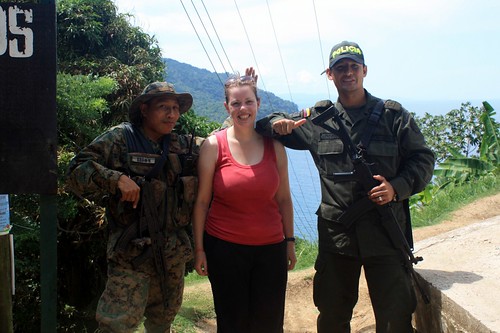
We then spent a couple of hours relaxing at La Miel beach, which had even bluer Caribbean waters than we had seen before, before returning back into South America and on to
Capurganá by boat.
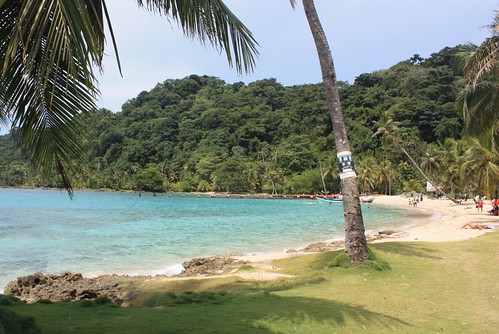
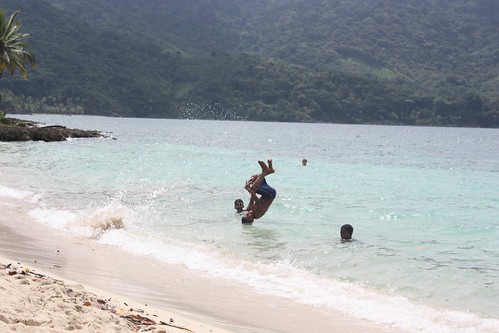
Capurganá is a very laid back place but all that suddenly changed when the weekly beer delivery arrived at the docks, filling up the port area with crates of beer that were
speedily carried on shoulders to waiting horse and carts that galloped around the town delivering the bottles to the waiting bars and restaurants.

There should have been a ‘Cheers’ themed bar in Capurganá , it would certainly be appropriate in a place where, after a day or two, everybody knows your name or at least
your face. We would meet somebody once and they would remember us, greet us and make us feel so welcome in their town for the rest of our stay. Capurganá is popular with Colombian holiday makers who all make a beeline straight
to the only resort complex in town, but apart from them there are hardly any other tourists, especially not foreigners, so even though you do stand out a little you are warmly received by everyone. One of our favourite
friends was 5 year old Juliana, who’s parents run the Coco Loco shack on the beach. Every afternoon she can be found playing in the sand and sea (what a way to grow up!) and when she spotted me she was fascinated by my Chico
Blanco skin and always wanted to tickle me and play with us in the waves and she had an infectious little giggle that she would frustratingly squeal every time we couldn’t understand her Spanish.
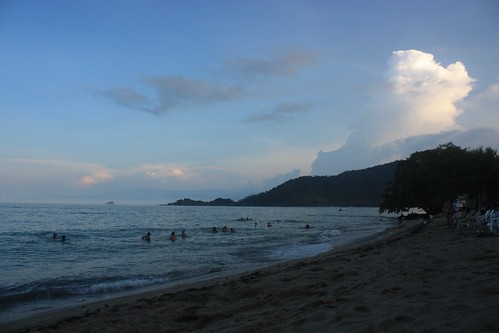
After meeting him at the border control we kept bumping into Alberto the Colombian border guard and on our last night he invited us out for farewell drinks to say adios to
both Colombia and South America. This was a real test of our Spanish as he speaks no English, but we spent the evening having a great time and lots of laughs when we couldn’t quite understand each other. I’m not quite
sure how the conversation got onto “breaking the seal” and to whether nudist beaches really exist in Europe and where the best ones are to be found! And we’re not still sure if it’s true that his police colleague who joined
us, Juane, was really Pablo Escobars nephew. He was from Medellin and didn’t seem too happy when Jo proclaimed how crazy she thought Roberto Escobar was, with him then deciding to tell us that he was an Escobar himself!
But the evening was a fitting send off to our time in both Colombia and America del Sur.

Colombia has had and still has many publicised problems, however it’s tourism slogan - “The only danger is.... not wanting to leave” - certainly rang true for us. It
was hard to leave Capurganá and even as I write this part of me wishes we were still there.
Colombia summary
Colombia really does have a bad reputation outside of South America and it is pretty unfitting and unjust. There is so much more to this beautiful country, much more than
we could fit into our six weeks. It is full of welcoming, warm, friendly locals, great food, coffee, art and wildlife, mixed in with cosmopolitan cities and old time country towns that haven’t changed for years.
We had such a wonderful time there that we can not recommend it enough. We never felt unsafe or worried about being kidnapped or running into cocaine barons (oopps). There are still problems in the country with narcotics and
the FARC, which will not disappear in a hurry, but as long as you don’t hire a car and drive off on random back roads to uncontrolled towns never visited by foreigners, you shouldn’t have any problems at all. We even heard
from some backpackers who’s bus was stopped by the FARC just two weeks ago, but they only wanted to talk to people about their political views, claiming that they want peace and don’t want to harm anyone and they only
deal in the cocaine business because it’s they only way they can make money to support their cause. I’m not saying we support them but isn’t it about time that we heard all sides of the stories here?
Highlights
Favourite Place - Capurganá and Salento (Both)
Favourite Attraction - Valle de Cocora walk and swimming in the Mar Caribe (Jo) Night Diving (Ryan)
Favourite Food - Arepa con Huevos Pericos (Jo) Bandeja Paisa (Ryan)
Favourite Beer - Club Colombia, but for the photo opportunity, Poker (Ryan)
Favourite Drink - Colombiana (Jo)

Lowlights
Our laundry taking so much longer to dry than the hostels told us it would take (and we had to dig really deep to find that one bad thing about Colombia)
For those of you thinking of possibly traveling to the region: Costs in USD
Accommodation - $20-30
Restaurant meal - $3-5
330ml Bottled Beer - $1
500ml Soft Drink - $0.75
1.5l Bottle of water - $1.5
Bus - $3-4 / hour
Ryan y Jo
Photos: http://www.flickr.com/photos/dojo77/